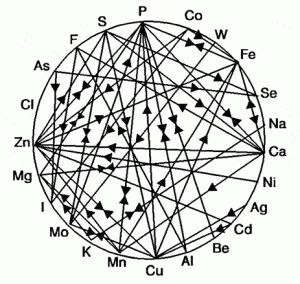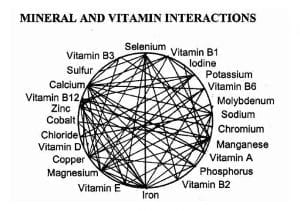
Hair is used for mineral testing because of its very nature. Hair is formed from clusters of specialized cells that make up the hair follicle. During the growth phase the hair is exposed to the internal environment such as blood, lymph and extra-cellular fluids. As the hair continues to grow and reaches the surface of the skin its outer layers harden, locking in the metabolic products accumulated during the period of formation. This biological process provides a blueprint and lasting record of mineral status and nutritional metabolic activity that has occurred during this time.
The precise analytical method (ICP-Mass spectroscopy with high quality control program) of determining the levels of 37 minerals in the hair is a highly sophisticated technique: when performed to exacting standards and interpreted correctly, it may be used as a screening aid for determining mineral deficiencies, excesses, and/or imbalances. HTMA (hair tissue mineral analysis) provides you and your health care professional with an economical and sensitive indicator of the long term effects of diet, stress, toxic metal exposure and their effects on your mineral balance that is difficult to obtain through other clinical tests.
It is important for the attending healthcare professional to determine your mineral status as minerals are absolutely critical for life and abundant health. They are involved in and are necessary for cellular metabolism, structural support, nerve conduction, muscular activity, immune functions, anti-oxidant and endocrine activity, enzyme functions, water and acid/alkaline balance and even DNA function. By measuring the mineral levels of your hair tissue, your account for the levels of these elements in your body’s extracellular matrix, where everything has to be in homeostasis in order to avoid disease.
Many factors can affect mineral nutrition, such as; food preparation, dietary habits, genetic and metabolic disorders, disease, medications, stress, environmental factors, as well as exposure to heavy metals. Rarely does a single nutrient deficiency exist in a person today. Multiple nutritional imbalances however are quite common, contributing to an increased incidence of adverse health conditions. In fact, it is estimated that mild and sub-clinical nutritional imbalances are up to ten times more common than nutritional deficiency alone.
The laboratory test results and the comprehensive report give an individual status for the present physiology of the organism and the tendency for sickness. This analysis is provided only as an additional source of information to the attending doctor or health professional.
Test results were obtained by a licensed clinical laboratory adhering to analytical procedures that comply with governmental protocol and standards after many years of clinical and laboratorial studies.
The report of the hair analysis includes the measurement of the individual’s all mineral levels, which are reported in milligrams percent (milligrams per one-hundred grams of hair. One milligram percent (mg%) is equal to ten parts per million (ppm). Specifically, it includes measurement of 15 nutritional elements (Ca, Mg, Na, K, Cu, Zn, P, Fe, Mn, Cr, Se, B, Co, Mo, S), which are considered essential for the major biological functions of the human body (muscular activity, endocrine function, reproduction, skeletal integrity, and overall development. It further includes measurement of 8 toxic elements (Sb, U, As, Be, Hg, Cd, Pb, Al), or heavy metals, which are commonly found in the environment and therefore are present in all biological systems. These metals concern very much our health when over accumulated in extracellular matrix. The last 14 additional elements (Ge, Ba, Bi, Rb, Li, Ni, Pt, Tl, V, Sr, Sn, Ti, W, Zr) measured are also considered very important for the human body, where many studies have been conducted for their importance and their requirements daily.
Furthermore, in the report included a complete individualized evaluation and detailed discussion of the patient’s metabolic type, current mineral levels and ratios, and the impact upon body chemistry. Also, there are recommendations of specific foods and food groups along with an explanation and why each food is suggested. Additionally, expert scientists advice supplements with no side effects based upon age, sex, metabolic type, and mineral patterns.

 Picture2. The antagonism and synergy among trace minerals and vitamins so the careless administration of dietary supplements can be avoided
Picture2. The antagonism and synergy among trace minerals and vitamins so the careless administration of dietary supplements can be avoided
It very important to be known that the diagnostic hair analysis issue has been studied from the past and has been proved with many clinical studies and are used by many clinicians to develop therapeutic approaches for most diseases. The diagnosis from this significant technology can provoke many serious diseases which have sympathetic or parasympathetic origin. These findings were reported the year 1989 and include diseases and conditions in international level. The sympathetic system includes the following disorders: anxiety, rheumatoid arthritis, allergens, diabetes (hypoinsulitism), bacterial infections, and hypertension, hyperthyroid, hypoparathyroid, hyperadrenia, Parkinson’s disease, true multiple sclerosis, peptic or duodenal ulcers, postmenstrual syndrome, immune suppression and others. The parasympathetic system includes the following disorders: Depression, osteoarthritis, allergies with low histamine, diabetes (hyperinsulinism), viral infections, hypotension, hypothyroid, hyperparathyroid, hypoadrenia, lupus, false multiple sclerosis, AIDS, gastric ulcers, premenstrual syndrome, immuno-deficiency and others.
For best quality diagnosis the collection of the hair sample is very important. Collection should be done under professional supervision, or by someone trained in proper collection procedures within a clean environment. Scalp hair is the only source recommended for analysis. Pubic and other body hair should only be used as a last resort if scalp hair is not available. The portion of hair to be collected should be untreated, i.e. not permed, dyed or bleached. If all of the hair has been chemically treated, wait until sufficient new virgin growth has emerged to allow collection. The hair should also be free of all gels, oils and hair creams prior to sample collection. For those individuals environmentally and/or occupationally exposed to external contaminants, (welding, mining, etc…) special care should be taken to limit exposure between washing of the hair and the collection of the sampled hair. Each collected sample should be taken in small portions from at least four to five different locations of the scalp. The recommended areas for collection are the nape of the neck, posterior vertex and posterior temporal regions. The length of the collected hair should not exceed one and one-half inches and the weight requested for a hair specimen is 125 milligrams (0.125 Gram).
Overall, the diagnosis by the hair mineral analysis protocol is very essential and quite detailed in providing a unique insight into nutritional biochemistry. Ιt is much more accurate from the serum analysis for all these trace elements because for the low cost and the accuracy of the storage levels that hair analysis provide, while serum just inform us about the temporary levels of minerals because they are transported to different tissues of the body, and not being stable. So, serum analysis can bring confusion to the evaluation of a patient. The other major advantage of the report in hair analysis is the regulation of the P.N.E.I (phyco-neuro-endrocrine-axis) and targeted detoxification, which can bring the balance of the human body, without the need of dietary supplements most of the time.
Properly followed by the guide of a professional health practitioner, this can then enhance the ability of the body to efficiently utilize the nutrients that are consumed, resulting in improved energy production and health.
Any person MUST do this analysis for prevention or even for better diagnostic results.
Bibliography
Ryabukhin, T.S.: International Coordinated Program on Activation Analysis of Trace Element Pollutants in Human Hair. Hair, Trace Elements, and Human Illness. Brown, A. C.; Crounse, R. G., ed. Praeger Publications, 1980.
Karpas Z, Lorber A, Sela H, Paz-Tal O, Hagag Y, Kurttio P, Salonen L., Measurement of the 234U/238U ratio by MC-ICPMS in drinking water, hair, nails, and urine as an indicator of uranium exposure source. Health Phys. 2005 Oct;89(4):315-21.
Metals and Neurotoxicology. Wright, RO, et al. J. Of Nutr. 138,12, 2007.
Copper, Chromium, Manganese, Iron, Nickel and Zinc Levels in Biological Samples of Diabetes Mellitus Patients. Kazi, TS, et al. Biol. Trace Elem. Res. 122,1, 200
Miekeley, N., et al. Elemental Anomalies in Hair as Indicators of Endocrinologic Pathologies and Deficiencies in Calcium and Bone Metabolism., J. Trace Elem. Med. Biol. 15, 1, 2005
Toxic Trace Metals in Mammalian Hair and Nails. United States Environmental Protection Agency Publication 1979; EPA-600/4: 79: 049.
Mercury as a Risk Factor for Cardiovascular Disease. J. Nutr. Biochem. 18, 2007.
Spallholz JE, Boylan LM, Palace V, Chen J, Smith L, Rahman MM, Robertson JD., Arsenic and Selenium in Human Hair; A comparison of Five Countries With and Without Arsenicosis., Biol Trace Elem Res. 2005 Aug;106(2):133-44.
Batzevich VA., Hair trace element analysis in human ecology studies., Sci Total Environ. 1995 Mar 15;164(2):89-98.
The Role of Mercury and Cadmium Heavy Metals In Vascular Disease, Hypertension, Coronary Heart Disease and Myocardial Infarction. Houston, MC. Altern. Ther. Health Med. 13,2,2007
Changes of Selenium, Copper and Zinc Content in Hair and Serum of Patients with Idiopathic Scoliosis. Dastych, M, et al. 2008 Orthopedic Research Society. Wiley Periodicals, Inc. J. Orthop. Res.
Longitudinal Hair Chromium Profiles of Elderly Subjects with Normal Glucose Tolerance and Type 2 Diabetes Mellitus. Stupar, J., et al. Metabolism. 56,1, 2007.
Strain, W. H.; Steadman, L. T.; Lankau, C. A.; Berliner, W. P.; Pories, W. J.: Analysis of Zinc Levels in Hair for the Diagnosis of Zinc Deficiency in Man. J Lab Clin Med 1966; 68.
Wang, CT, et al., Concentrations of Calcium, Copper, Iron, Magnesium, Potassium, Sodium and Zinc in Adult Females hair with Different Body Mass Indexes in Taiwan., Clin. Chem. Lab. Med. 43, 4, 2005.
Evaluation of Toxic Metals in Biological Samples (Scalp Hair, Blood and Urine) of Steel Mill Workers by Electrothermal Atomic Adsorption Spectrometry. Afridi, HI, et al. Toxicol. Ind. Hlth. 9, 2006.
Determination of Cadmium in Whole Blood and Scalp Hair Samples of Pakistani Male Lung Cancer Patients by Electrothermal Atomic Absorption Spectrometer. Kazi, TG, et al. Sci. Total Environ. 389,2, 2008.
Leung PL, Huang HM, Sun DZ, Zhu MG., Hair concentrations of calcium, iron, and zinc in pregnant women and effects of supplementation., Biol Trace Elem Res. 1999 Sep;69(3):269-82.
Gill US, Schwartz HM, Bigras L., Results of multiyear international interlaboratory comparison program for mercury in human hair., Arch Environ Contam Toxicol. 2002 Nov;43(4):466-72.















